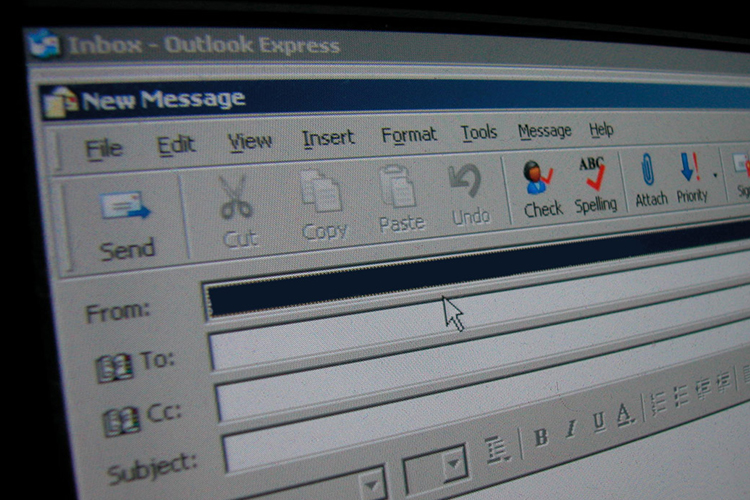Tips to improve workplace email etiquette

Email has become an essential communication tool in the workplace, however, if not used properly it can lead to problematic situations. Sometimes FIs come to me or my colleagues with problems based on – or exacerbated by – miscommunication or other violations of email etiquette. In fact, improper use of email can not only cause you problems at work but it can also reflect badly on you and your department.
It is in this context that I want to share some of the tips you can use to improve your work-related email communication. Some of these probably seem like common sense but it’s useful to keep them in mind. Let’s proceed step by step.
Recipients
Email is designed in a way that your recipient’s email address is the first thing you write when want to send an email message. However, this is not necessarily a good process to follow. I’ll explain why. When you have your recipient’s email address filled in, when you hit send, accidentally or not, your message will be sent whether it is complete or not. This is why I suggest that you add your recipient’s email address after finishing the message and verifying that everything looks good. This will also help you double check the email address to avoid sending your message to the wrong person or having it go undelivered entirely.
Speaking of recipients, you should be sure to use CC and BCC cautiously. While the addresses you put in the To field are for people you would like to take action, those you put in CC field are for those you think should take note of the message but don’t necessarily need to take any action. Before adding any colleagues to your cc list, ask yourself if their inclusion serves a purpose. Use BCC function only when you don’t want others to see who else an email was sent to.
Similarly, when replying to emails, use the “reply all” function only when you think everyone on the list needs to receive the email. Avoid jamming people’s inboxes with unwanted communication.
Subject lines
The subject line is supposed to give your recipient an idea of the content of your email. In fact, most people skim through their inboxes and choose which messages to open based on the subject line. It is therefore important to keep the subject line short and reflective of the message you want to communicate.
Having said that, you should avoid using the subject line as a text message. I sometimes see people putting the whole email in the subject line, leaving the body of the email blank. This is not only annoying but also can be seen as laziness. If your email can fit in a subject line, perhaps the message is better suited to an in-person conversation or phone call.
Salutation
Since the salutation is the first word of your email, it should be polite and professional to help you get the attention of your reader. It’s recommended to use Hi or Hello followed by the receiver’s first name. To be more formal you can use “Dear (insert name). Salutations such as ‘Hey’ are only fine for friends and family. Also, you shouldn’t use nicknames or shorten a person’s name (For example: Rob for Robert) unless you’re given permission to do so.
Also, make sure you spell the name of the recipient correctly. Even an innocent mistake with someone’s name could be taken personally by the recipient, setting a negative tone even before the substance of the email is addressed.
Language and tone
Because the way we communicate is as important as the message itself, there are a couple of points to remember when composing the body of your email to ensure that it sends the right message and tone.
You should use clear and concise language to avoid confusion and unnecessary back and forth. In an indirect communication such as email, it is not easy to address misunderstandings and sometimes it can take endless messages back and forth to get to the point.
Similarly, you should stick to one topic per email to facilitate tracking a conversation on a specific subject. When you discuss a topic in different email threads with different subject lines, it becomes hard to keep track of it. For example, don’t discuss sick leave, updates on Project X and feedback on a new pay system in one email.
It is also recommended that you keep a friendly tone and avoid sending emotional messages. This is important especially when you’re angry at your boss or unhappy about a situation. Try to remain calm and refrain from using all-capital letters and multiple punctuation marks to show how angry you are.
On a similar note, you should refrain from relying on humour and sarcasm because they can be easily lost in translation without the right tone and facial expression and this can create unwanted consequences.
Finally, if you communicate with someone often, you should study and adapt to their style and tone. For example, if they send short emails that might mean they are busy so don’t send long emails unless it’s absolutely necessary. If you do have to write a long email, be sure to include a short summary.
Format and other things to remember
Apart from language and tone, there are other tricks and tips to keep in mind to improve your email.
Flag your emails a high priority only when it is really urgent. Overusing this feature can cause it to lose its value and few people will take your messages seriously. To avoid this, grab the attention of your recipient by choosing a catchy subject line.
Try avoiding formatting your message using special fonts that you wouldn’t use in a regular letter. The recipient may not have a system to display the message as it appears on your system. Whenever possible, use classic fonts such as Times New Roman and Arial. You should also use paragraphs to organize ideas in your email.
It is strongly recommended to edit and proofread your email before sending it. It is a no-brainer that sending an email full of spelling errors and sloppy language can make the person reading it think that you’re unprofessional and careless. This can also reflect poorly on your department.
Similarly, you should avoid internet slang and text abbreviations in a professional email unless the recipient is someone with whom you have a casual relationship. For example: Use “as soon as possible” instead of “ASAP” and “thanks” instead of “thx.”
If you attach a document to your email, you should always mention it so your recipient doesn’t overlook it. For example: “I have attached a report for January. I would be grateful if you could read it and let me know if there is something I have missed”. Likewise, if you refer to an attachment in your email make sure you don’t forget to attach it.
Lastly, remember that privacy cannot be absolutely guaranteed because your employer may find cause to read information sent using their electronic network. Therefore, you should avoid sending any personal information from or to work even if your recipient is someone with whom you have a relationship outside of work. Additionally, Government of Canada emails are subject to access to information legislation and may become public as part of an inquiry from a journalist or researcher.
Closing
The way you end an email or any other conversation influences the lasting impression of you on the recipient. It is therefore recommended to use a complimentary closing that complements the tone and content of your email. Here are some formulas you can adopt:
General Professional Emails:
Regards/Best Regards
Sincerely
Kind Regards
Best/Best Wishes/All the best
Informal closings can also be used:
Thanks
Have a great day/ weekend/ holiday
Enjoy your day
Have a good one
It is also recommended to add a signature at the end of your email. It helps your recipient to know more about you and how to contact you. Usually, a signature includes your name, position, organization, and contact information. Most organizations have email signature policy, be sure to check what yours uses. Example:
Mathieu Delorme
Labour Relations Advisor / Conseiller en relations de travail
Association of Canadian Financial Officers / Association canadienne des agents financiers
400 – 2725 Prom. Queensview Dr. – Ottawa, ON – K2B 0A1
Tel./Tél.: 613-728-0695 ext. 244 – Fax/Télécopieur: 613-761-9568
www.acfo-acaf.com
Finally, you should do another round of check before hitting “send.” Nobody likes that feeling you get after sending an email then you realize you missed a point or didn’t attach a document.
I hope these tips help you avoid unnecessary issues in the workplace. As always, though, if you do find yourself facing challenges at work, don’t hesitate to get in touch at labourrelations@acfo-acaf.com.
Mathieu Delorme
Labour Relations Advisor





